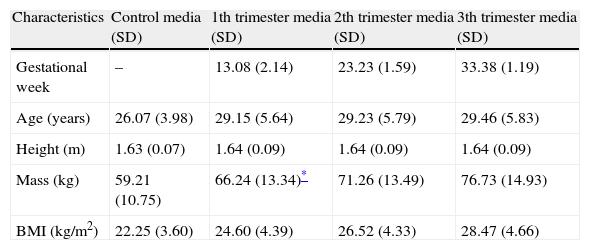The aim of this study was to evaluate static and dynamic postural control during the three trimesters of pregnancy and to check the quality of life in each trimester.
MethodsThis is a descriptive study in which posturographic tests were applied in four still standing positions, for three trials, with a combination of different visual conditions and support base configurations. The variables of ground reaction force (GRF) were also analyzed during the gait stance phase through the force platform and the quality of life. The study included 20 non-pregnant women and 13 pregnant women during the gestational period. The variables analyzed were statokinesigram, time and value of the first and second peak and the valley of the vertical component of GRF, time and maximum and minimum value found in the anterior–posterior horizontal component.
ResultsCompared to control group, pregnant women had larger center of pressure displacement areas, longer time in the first phase of weight acceptance, lower values of first and second peaks of the vertical component and lower maximum and minimum values of the anterior–posterior horizontal component of the GRF. With respect to quality of life, the physical domain was the most affected in the first trimester.
ConclusionThe results demonstrate that in the beginning of the pregnancy, the woman's body seems to already change postural control, and during the trimesters, there is a trend to reduction in postural stability.
El objetivo de este estudio fue evaluar el control de la postura estática y dinámica durante los tres trimestres del embarazo y comprobar la calidad de vida en cada trimestre. Métodos: Se realizó un estudio descriptivo en el que las pruebas posturograficas se aplicaron en cuatro posiciones de pie, de tres ensayos, con una combinación de diferentes condiciones visuales y las configuraciones de base de apoyo, también se analizaron las variables de la fuerza de reacción del suelo (GRF) en la posición de marcha a través de la plataforma de fuerza, y la calidad de vida. El estudio incluyó 20 mujeres no embarazadas y 13 mujeres embarazadas durante el período gestacional. Las variables analizadas fueron: statokinesigram, el tiempo y el valor del primer pico y el segundo y el valle de la componente vertical de GRF, el tiempo y el valor máximo y mínimo de la componente horizontal antero-posterior.
ResultadosEn comparación con el grupo control, las mujeres embarazadas tenían más centro de las zonas de desplazamiento de presión, mayor tiempo en la primera fase de aceptación de peso, los valores más bajos de los primero y segundo picos de la componente vertical y menores valores máximos y mínimos de la horizontal antero-posterior componente de la GRF. Con respecto a la calidad de vida, el dominio físico fue el más afectado en el primer trimestre.
ConclusiónLos resultados demuestran que, al principio del embarazo, el cuerpo de la mujer parece cambiar ya el control postural, y durante el trimestre hay una tendencia a la reducción en la estabilidad postural.
Artículo
Si ya tiene sus datos de acceso, clique aquí.
Si olvidó su clave de acceso puede recuperarla clicando aquí y seleccionando la opción "He olvidado mi contraseña".Comprando el artículo el PDF del mismo podrá ser descargado
Precio 19,34 €
Comprar ahora













